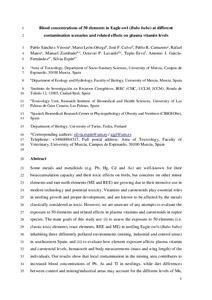Blood concentrations of 50 elements in Eagle owl (Bubo bubo) at different contamination scenarios and related effects on plasma vitamin levels
Sanchez-Virosta Pablo; Leon-Ortega Mario; Calvo Jose F.; Camarero Pablo R.; Mateo Rafael; Zumbado Manuel; Luzardo Octavio P.; Eeva Tapio; García-Fernandez Antonio J.; Espín Silvia
https://urn.fi/URN:NBN:fi-fe2021042824062
Tiivistelmä
Some metals and metalloids (e.g. Pb, Hg, Cd and As) are well-known for their bioaccumulation capacity and their toxic effects on birds, but concerns on other minor elements and rare earth elements (ME and REE) are growing due to their intensive use in modern technology and potential toxicity. Vitamins and carotenoids play essential roles in nestling growth and proper development, and are known to be affected by the metals classically considered as toxic. However, we are unaware of any attempts to evaluate the exposure to 50 elements and related effects in plasma vitamins and carotenoids in raptor species. The main goals of this study are: (i) to assess the exposure to 50 elements (i.e. classic toxic elements, trace elements, REE and ME) in nestling Eagle owls (Bubo bubo) inhabiting three differently polluted environments (mining, industrial and control areas) in southeastern Spain, and (ii) to evaluate how element exposure affects plasma vitamin and carotenoid levels, hematocrit and body measurements (mass and wing length) of the individuals. Our results show that local contamination in the mining area contributes to increased blood concentrations of Pb, As and Tl in nestlings, while diet differences between control and mining/industrial areas may account for the different levels of Mn, Zn, and Sr in blood, and lutein in plasma. Plasma tocopherol levels were increased in the mining-impacted environment, which may be a mechanism of protection to prevent toxic element-related oxidative stress. Plasma α-tocopherol was enhanced by 20% at blood Pb concentrations ≥8 ng/ml, and nestlings exhibited up to 56% increase in α-tocopherol levels when blood Pb concentrations reached 170 ng/ml. Tocopherol seems to be a sensitive biomarker under an exposure to certain toxic elements (e.g. Pb, As, Tl).
Kokoelmat
- Rinnakkaistallenteet [27094]
